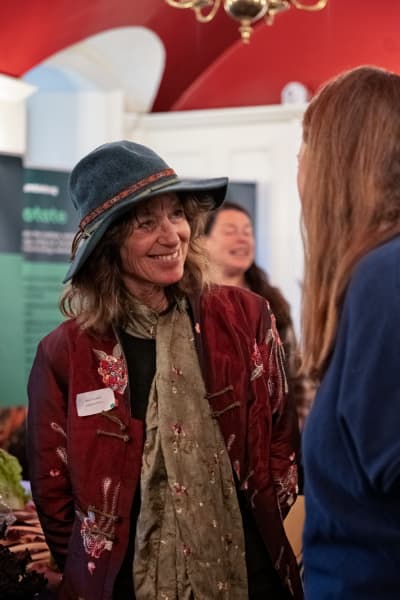Guest post by Lukie Tolhurst (lucid-insight.com), with photos by Lukie Tolhurst and Nina Osswald
You know someone is a good grower when they have had to change a vegetable variety because their own seeds were starting to produce such big roots they were too large to sell. Meet Iain Tolhurst of Tolhurst Organic.

Despite our matching surname, we have never met before, but I was lucky enough to do just that on the 30th October on a small, socially distanced tour which Good Food Oxford organised as part of the Oxfordshire Pumpkin Festival, so that we could catch a glimpse of the innovative inner-workings of Iain’s farm. For many the COVID-19 lockdown has been at best frustrating and at worst devastating. However, like many local suppliers serving their communities, Tolhurst Organic has seen a huge surge in interest and support that surpasses anything seen in their previous 44 years as growers. For them, the pandemic has resulted in a marked shift towards greater acceptance and understanding of their hard work and ‘alternative’ approaches, resulting in a huge increase in demand. Hopefully it will be a shift in consciousness that sticks well beyond this pandemic.
The love of learning and experimenting is very much embedded into the culture of the organisation.
The enthusiasm of Iain Tolhurst, known as Tolly, is delivered in tsunami waves of knowledge throughout the tour. This level of sustained enthusiasm is no mean feat. His work over many decades as a livestock-free organic producer, meaning no inputs from farmed animals at all, has been pioneering, and he has had to test and develop many approaches the hard way, without a guidebook to follow. This means constantly taking risks and accepting that certain things will ‘fail’ as part of that learning process, over and above the standard perils of any gardener battling with our unpredictable weather as well as the consequences of climate change. For many this would have been overwhelming to breaking point. But it is clear that the love of learning and experimenting is very much embedded into the culture of the organisation and keeps it interesting for the team. As we make our way across the farm, I cannot help but think that this is the very key to their success: test–fail–learn–repeat until the best possible solution is found, then move onto something new to learn, and they have managed all that within the tolerances of a successful commercial enterprise.
The following approaches to soil fertility, pests and diseases, within the context of stock-free growing, particularly struck home for me:
Firstly, soil function and fertility. It is now widely accepted by regenerative growers that protecting the soil surface is crucial to prevent erosion and to support the microbiota population within. Many market gardens and no-dig gardeners are currently engaged in a high compost input model, using thick covers to provide nutrients, armour the soil and prevent weed growth. However, at Tolhurst Organic they apply compost at levels which are fascinatingly low. For instance, they apply a very precise but modest amount every 4 years in the greenhouse systems and every 9 years in the walled garden. For field crops, woodchip compost is applied at 50-70 cubic meters per hectare for the two years of fertility building crops within the 7-year vegetable rotation. The compost is sourced from woodchip from a local tree surgeon with a very small proportion of green waste from the farm, which they compost themselves on-site.

This low-level input came as a complete surprise to me, but now I think about it, it makes a whole lot of sense. There are many well documented problems with using a large volume of compost:
- Cost of purchasing (most market gardens cannot generate large amounts of compost on site)
- Carbon footprint of transport
- Quality issues: Many gardens have had problems with poorly composted material, contamination (such as Aminopyralid) or nutrient imbalances.
- Manual labour required to manoeuvre huge volumes of material onto the beds
"Soil obesity – overloading the soil with carbon and phosphate from compost – can have a negative impact on the microbiology balance."
But the really interesting point made by Tolly is that applying too much compost could actually be detrimental to the soil biology. He coined the term ‘soil obesity’ to describe overloading the soil with carbon and phosphate from compost which he believes can have a negative impact on the microbiology balance, resulting in locking up key elements and nutrient deficiencies in the crop. Not only have they proven that too much feeding can be counter-productive, but that the ideal levels are surprisingly low, hence the application rates mentioned above.

Instead of applying compost, Tolhurst Organic use living natural systems to do most of the hard work, and this comes down to diversity, diversity, diversity! Like rewilding, this is a very process orientated approach: they aren’t just farming crops, but encouraging a whole set of flourishing ecosystem processes, which means that the produce will gain nutrients from the activity of soil organisms and be significantly protected from pests and disease and thereby thrive. Apart from avoiding any chemical spraying, Tolly explained two key approaches to supercharge this synergistic farm ecosystem: a) the use of diverse green manures and b) permanent natural refuges for biodiversity.
The green manures are in play almost constantly, sown in the beds once young crop plants are established, and grown in resting beds for 2 years as part of the rotation. The green manures are carefully compiled mixtures of broadleaf plants, legumes and grass species, including deep-rooted species to mine for those all-important minerals, but ‘weeds’ are allowed too: “You won’t get rid of them, you’ll just die young [trying], so why bother?” says Tolly. The key is to keep the soil occupied with living plants as much as possible. The resultant roots aerate the soil and their carbon exudates feed the fungi, bacteria and animals in the soil. This results in a healthy diverse ecosystem of beneficial organisms, which in turn provides pest and disease protection, as well as minerals and other nutrients back to the crops.

This leaves a difficult choice with regards to soil disturbance, which Tolly was at pains to explain to the group: Green manures require some minimal tillage to make space for the next crop to establish, which will inevitably damage soil structure and microbiota to some degree. However, his experience is that within their system the soil copes with light tillage where needed between crops and overall, he has found that having living cover is more beneficial compared to the use of high levels of compost to prevent weed growth and keep the beds ‘clean’. It should be noted that this transition to lower compost inputs was implemented over time, as the soil biology has regenerated.
Permanent two meter-wide ‘beetle banks’ with mixed wildflowers amongst the vegetable beds support huge numbers and diversity of insects that help manage crop pests.
As well as the benefits of healthy soil biology, Tolly also understands how broader ecosystem diversity benefits his crops. He has permanent two meter-wide ‘beetle banks’ amongst his beds with mixed wildflowers that support huge numbers and diversity of insects that again help manage crop pests. These are not cut and tidied, and over winter they provide shelter in the stems for insect populations to survive into the following year. The refuges are carefully linked to other natural habitats to create corridors such as between trees and hedges. This hands-off approach meant letting go of being very tidy around the edges for the greater benefits gained from supporting the inhabitants. He noted his own transition many years ago once he realised the positives of encouraging nature within the system when he “shifted from trying to kill everything … to working with – not against”. Another benefit is that the beetle banks are permanent root refuges between beds, providing habitat for soil microorganisms that can help recolonise nearby beds after they are tilled. The knock-on effects work all the way up the system to the many birds of prey that help balance rodent levels.

But at the end of the day, the proof is in the pudding. Well, the vegetables. Testament to their approach is that their overall incidence of disease and pests, such as flea beetle and cabbage white is extremely low, and productivity is extremely high. They produced 120 tonnes across 350 different crops this year, including 25,000 brassicas, 2 tonnes of strawberries and 19 tonnes of potatoes. All that in addition to, and most likely because of, the nurturing of huge volumes of soil organisms, including 13 million earthworms (around 10 tonnes) per hectare. Earthworms are an indicator of a thriving soil community, and given the farm covers 7 hectares that figure suggests a vast amount of soil-based biota living on the land.
Tolhurst Organic is a wonderful example of how people’s part in nature can lead to a highly productive and healthy system for all its inhabitants, human and non-human alike. Thanks to Tolly and Good Food Oxford for the opportunity to see this system in action.
More info about Tolhurst Organic, Lin’s Veg Shed and veg box subscriptions at www.tolhurstorganic.co.uk



To find out more about veganic growing, visit www.veganorganic.net, and tune in to see Tolly live at the Veganic Farmer's Question Time on 26th November. To get your questions about stock-free growing answered, send them in before the 26th.



